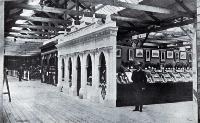Australian Courts
- The Australian Courts at the Exhibition displayed the products of New Zealand’s nearest neighbour.
- Products generally reflected the mineral wealth present in Australia and the all important agricultural industry.
New South Wales
Covering an area of 10,000 square feet (930 square metres) the New South Wales Court celebrated the agricultural, pastoral, mining and commercial interests of the State. The main part of the exhibit was given over to the enormously important and valuable wool industry while the agricultural bay contained exhibits from the State experimental farms at Bathurst and Wagga Wagga.
There was also a "wonderfully complete display of mineral products"1 included manganese, coal, gold, silver, lead, copper and tin, and particularly beautiful marble, along with such unusual products as wolfram and molybdenite. The commercial products on display included pianos, wines, soaps, furs and woodwork. The walls were decorated with a large number of panoramic photographs and the court also included paintings, drawings and models from the Sydney Technical College.
Victoria
This court occupied a space of 6,800 square feet (632 square metres), its main drawcard being an "enormous gilt obelisk, representing a quarter of the solid gold won in Victorian "diggings" and mines during the past fifty-five years".2The obelisk measured 11 feet 6 inches (3.5 metres) square at the base and represented gold valued at £63,301,625. Models of the largest gold nuggets found in Victoria completed the display.
Other displays included a very large stand of wine and brandy, "fine pieces of statuary"3 from the Melbourne Exhibition Trustees, and a number of valuable paintings. The commercial exhibits included furs, racing clinkers (boats), footwear, dried fruits, paper patterns and dress-stands, knife-cleaners and sharpeners, tents, rabbit-traps, sheep dip, and agricultural machinery.
South Australia
This small display in a 1000 square foot (93 square metres) pavilion was entitled "Corn, Wine and Oil" and demonstrated that the State produced "an overflowing abundance of the fruits of the earth".4 Wines and dried and preserved fruits were the main items on display, since the Court was organised by local winemakers and fruit growers, rather than the State government. Several shipments of table-grapes during the Exhibition sold immediately at good prices and led to the regular importation of Australian grapes to New Zealand. There were also displays of grain, minerals and tanning products, together with maps, plans and photographs of public buildings and tourist resorts. For many visitors, the "most interesting items … [were] the specimens of animal life found in the great Northern Territory":5 turtles, sea-tortoises, buffalo horns, crocodile and alligator heads, and dugong.
![]()
Related photos
 The Front and Western Side of the Court |
Sources
- Cowan, J. Official record of the New Zealand International Exhibition of Arts and Industries held at Christchurch, 1906-7, page 249-260
- "Turtles and Crocodiles - Specimens from the Northern Territory", The Star, 26 November 1906, page 3
- The Weekly Press, 7 November 1906, page 109-110
Footnotes
- [1] "New South Wales", The Weekly Press, 7 November 1906, page 109
- [2] Cowan, J. Official record, page 255
- [3] Cowan, J. Official record, page 257
- [4] "South Australia", The Weekly Press, 7 November 1906, page 110
- [5] "Turtles and Crocodiles - Specimens from the Northern Territory", The Star, 26 November 1906, page 3




